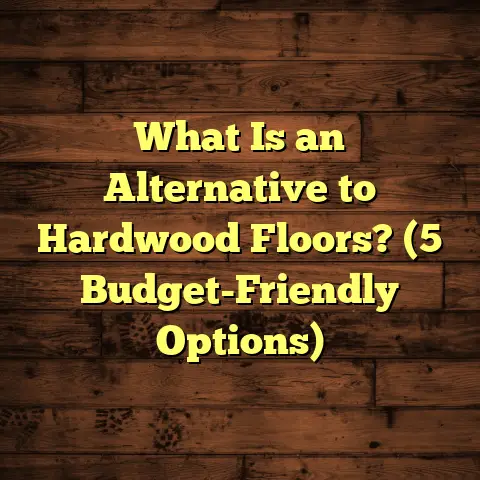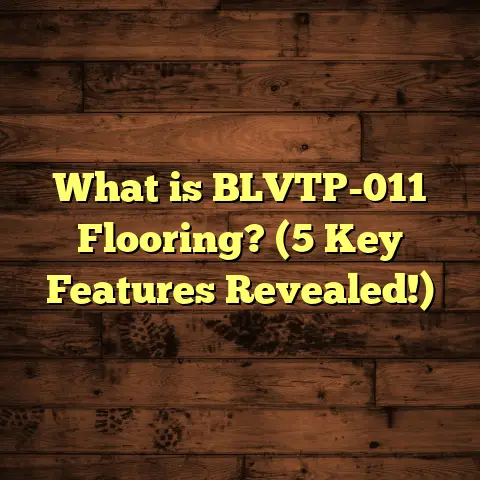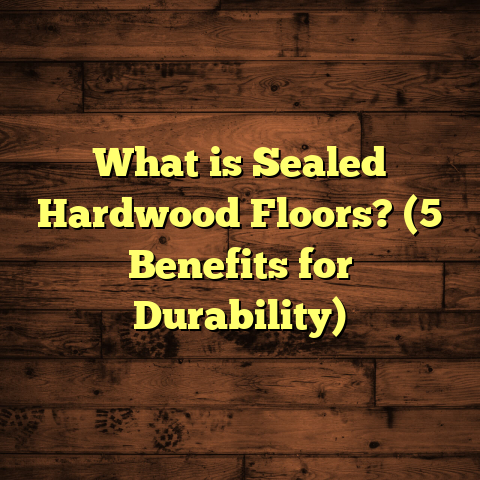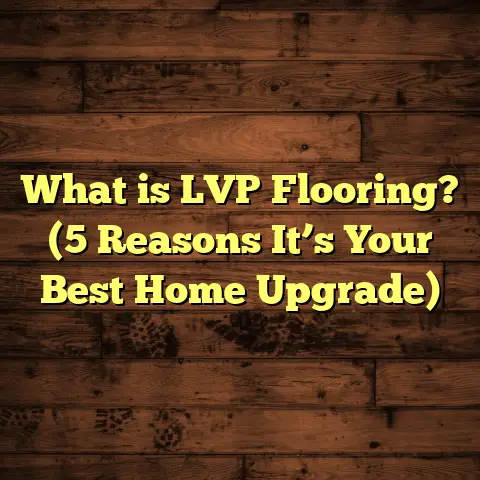What is a Flooring System? (5 Essential Types Explained!)
I’ve always been fascinated by the way a room feels under my feet — like a silent
storyteller that shapes the whole mood. Whether I’m unwinding after a long day or
hosting friends, the floor beneath me plays a huge role in comfort and style. That’s
what got me hooked on learning everything about flooring systems. If you’re curious
about what a flooring system really is, and want to understand the main types,
stick with me. I’ll share some personal stories, data, and insights I’ve gathered over
years of hands-on work.
What Is a Flooring System?
So, what is a flooring system exactly? At its core, a flooring system is the complete
setup that makes up the floor in any building. It’s not just the surface you see; it’s
also the layers beneath that provide support, insulation, moisture control, and
sometimes even soundproofing. Think of it as an entire team working together to
create a durable, attractive floor that fits the room’s purpose.
A typical flooring system includes:
- The subfloor: This is the structural base, usually made of plywood or concrete.
- Underlayment: This layer cushions and smooths out imperfections between subfloor and finish.
- The finish layer: This is what you walk on—hardwood, tile, carpet, or vinyl.
- Vapor barriers or moisture shields: These protect against water damage.
- Adhesives or fasteners: To hold everything firmly in place.
Each component plays a part in how your floor feels, lasts, and performs. If one part
fails or is installed poorly, the whole system suffers.
Why Does This Matter?
I remember one project where a beautiful hardwood floor was installed directly over
a concrete slab with no moisture barrier underneath. Within a few months, the wood
started warping and buckling. It was a costly mistake that could have been avoided
with proper layering. That experience taught me the importance of understanding
each piece of the flooring system puzzle.
Have you ever wondered why some floors last forever while others crack or warp in just a few years? It often comes down to the flooring system’s design and installation quality.
The 5 Essential Types of Flooring Systems
Over time, I’ve worked extensively with different flooring systems, each with its own
set of pros and challenges. Let me walk you through the five essential types I’ve seen
most often:
1. Solid Hardwood Flooring System
This is probably the classic flooring many imagine when thinking about wood floors.
How it works: Solid hardwood planks are nailed or glued directly onto a wooden
subfloor or plywood. They can be sanded and refinished multiple times over their life.
What Makes Solid Hardwood Special?
There’s something magical about solid hardwood floors. When I installed my first solid hardwood floor in a client’s living room years ago, I was amazed at how the natural grain patterns brought warmth and character to the space. It wasn’t just flooring—it was art underfoot.
You might be asking: why choose solid hardwood over other options? Here are some key points:
- Longevity: With proper care, solid hardwood can last over 100 years.
- Refinishing ability: You can sand down scratches or dents multiple times.
- Natural insulation: Wood naturally regulates temperature and humidity better than many materials.
- Resale value: Homes with hardwood floors often sell faster and at higher prices.
In fact, according to the National Wood Flooring Association (NWFA), installing solid hardwood floors can add approximately 3% to 5% to your home’s resale value. That’s a significant boost when you think about real estate markets.
Challenges I’ve Faced with Solid Hardwood
But solid hardwood isn’t perfect. During one winter installation in a chilly northern home, we ran into trouble with moisture levels. The wood expanded after installation because the heating system wasn’t turned on yet to stabilize indoor humidity. This caused gaps and minor buckling.
Here are some challenges I’ve encountered:
- Moisture sensitivity: Wood absorbs water and expands or contracts.
- Installation skill: Requires precise nailing or gluing to avoid squeaking.
- Cost: Higher material and labor costs compared to laminate or vinyl.
- Maintenance: Needs regular cleaning and occasional refinishing.
If you love the look but worry about moisture (especially if you have pets or a basement), solid hardwood might require additional planning like proper vapor barriers or humidity control systems.
2. Engineered Hardwood Flooring System
Engineered hardwood is like hardwood’s practical cousin: it offers similar looks but with more stability.
How it works: Thin layers of real wood veneer are bonded over plywood or high-
density fiberboard (HDF). This layered construction reduces expansion and contraction.
Why I Recommend Engineered Hardwood for Many Projects
One memorable project involved installing engineered hardwood in a basement family room prone to dampness. Solid wood would have warped quickly there. Engineered floors handled the moisture better and gave us that real wood look everyone loves.
Some advantages:
- Moisture resistance: Less likely to warp than solid wood.
- Installation flexibility: Can float or be glued down.
- Appearance: Real wood top layer means authentic look and feel.
- Cost efficiency: Usually less than solid hardwood but more than laminate.
Data from industry sources show engineered hardwood sales increasing steadily—expected growth of around 6% annually—due to these benefits.
Drawbacks I’ve Seen
That said, engineered hardwood comes with some trade-offs:
- Generally only refinished once or twice (versus multiple times for solid wood).
- Some cheaper products use very thin veneer layers which wear out faster.
- Installation still requires some skill for best results.
Once I worked on a project where the veneer was too thin; after heavy foot traffic in just five years, the floor looked dull and needed full replacement rather than refinishing.
3. Laminate Flooring System
Laminate is often mistaken for wood but it’s actually a multi-layer synthetic product.
How it works: A photographic layer mimics wood or stone, topped with a tough clear wear layer. It’s installed as a floating floor over an underlayment.
Why Laminate Became My Go-To Budget Option
For years I hesitated about laminate because I thought it looked cheap. Then I installed a high-quality laminate in a rental property with kids and pets—and was blown away by how durable it was.
Advantages include:
- Affordability: Laminate costs around $1-$5 per square foot.
- Durability: Resistant to scratches and dents.
- Easy installation: Click-lock floating style means quick DIY projects.
- Low maintenance: No special cleaners needed; regular sweeping works fine.
According to market research by Grand View Research, laminate flooring demand continues growing at approximately 5% CAGR, driven by affordability for new homeowners and renters alike.
Where Laminate Falls Short
But laminate isn’t perfect:
- You can’t refinish it once worn out.
- Sensitive to water damage if seams are exposed.
- Not as warm or quiet as wood or vinyl floors.
I remember one tenant who spilled a lot of water from their fish tank on laminate floors repeatedly without drying it up fast enough. The planks swelled and had to be replaced.
4. Vinyl Flooring System
Vinyl has come a long way from sticky sheets in old kitchens. Now it’s versatile and stylish.
How it works: Made from PVC, vinyl comes in sheets, tiles, or planks often with a wear layer for protection. It’s installed over subfloor with adhesive or as floating floors.
My Experience with Luxury Vinyl Planks (LVP)
When luxury vinyl planks hit the market, I knew they’d change how people see vinyl floors. I installed LVP in a client’s busy kitchen last year. The floors were waterproof, comfortable underfoot, and looked like real wood—without the maintenance hassles.
Key benefits:
- Waterproof options: Great for bathrooms, kitchens, basements.
- Variety of styles: From wood looks to stone patterns.
- Comfort: Softer underfoot than tile.
- Affordable luxury: Mid-range cost between laminate and hardwood.
Industry reports show luxury vinyl tile sales growing by over 15% annually, reflecting strong consumer demand for durability combined with beauty.
Vinyl Flooring Issues I’ve Encountered
Still, vinyl has its quirks:
- Prone to dents from heavy furniture or sharp objects.
- Can fade with prolonged sun exposure.
- Environmental concerns due to PVC content.
One time I had to replace vinyl flooring after a heavy cast iron stove leg left permanent marks on the surface—something that wouldn’t happen on tile but can on vinyl.
5. Tile Flooring System
Ceramic or porcelain tile is one of the most durable flooring choices out there.
How it works: Tiles are set in mortar on a concrete or cement backer board base, then grouted between joints.
Why Tile Remains Popular After All These Years
Tile is my go-to for bathrooms and kitchens because nothing beats its water resistance and longevity. On one bathroom remodel project, we used large format porcelain tiles which created a sleek look with minimal grout lines—a modern twist that clients loved.
Tile benefits include:
- Durability: Lasts decades with minimal wear.
- Waterproof nature: Perfect for wet areas.
- Design variety: Colors, shapes, patterns galore.
- Low maintenance: Easy to clean.
The Home Innovation Research Labs found that over 30% of new homes include ceramic/porcelain tile flooring in kitchens or baths.
Challenges Installing Tiles
But tile installation isn’t easy:
- Requires very flat subfloor; even small bumps cause cracks.
- Labor-intensive process raises cost.
- Hard surface can feel cold and unforgiving underfoot.
I once spent two days leveling an uneven plywood subfloor before we could even start laying tile in a client’s kitchen—patience is key here!
Common Flooring System Challenges & Lessons Learned
Not every project goes smoothly. Flooring systems are complex setups where mistakes
in one layer can cause problems down the road. Here are some common issues I’ve run
into:
Moisture Problems
Moisture is by far the biggest enemy across many flooring types. Without proper vapor
barriers or drainage solutions, wood can warp, laminate can swell, tiles can loosen.
For example, I once worked on a renovation where the old concrete slab wasn’t tested
for moisture before laying flooring on top. Months later, the homeowner found bubbles
under vinyl planks. We had to pull everything out and install a moisture barrier—
costly but necessary.
Uneven Subfloors
An uneven subfloor causes squeaks, cracks in tile grout, or uneven wear on surfaces. I’ve learned to always check subfloors with laser levels before starting any install.
Material Waste & Cost Overruns
Estimating material needs accurately is tricky but critical to avoid waste and extra costs. Early on, I’d often order too much or too little material — which slowed projects down.
To tackle this, I started using FloorTally — an online tool that helps me calculate costs by factoring local labor/material prices and waste percentages. It’s saved me tons of time and headache by giving more realistic budgets upfront. Plus, it helps me visualize total costs clearly before buying anything—no guesswork!
Diving Deeper: The Science Behind Flooring Performance
You might wonder why different flooring materials behave so differently under stress? Here’s some insight from my own research combined with industry data:
Thermal Expansion & Contraction
Wood floors expand in humid conditions and contract in dryness; this movement can be as much as 1/4 inch across wide planks. Engineered hardwood reduces this by layering materials in cross-grain directions for stability.
Vinyl contracts less but can still have seam issues if not installed right.
Load Bearing & Impact Resistance
Tile can bear heavy loads without damage but cracks under impact if substrate isn’t firm.
Laminate resists scratches but can’t handle heavy gouges well — vinyl falls somewhere between these extremes.
Acoustic Properties
Hard surfaces like tile echo sound; wood absorbs noise better. Underlayment choices help balance this for comfort.
Flooring Trends & Innovations I’m Excited About
I keep an eye on new materials and techniques that improve floors’ looks and function:
- Reclaimed Wood Flooring: Eco-friendly option gaining popularity; each plank tells its own story.
- Waterproof Engineered Floors: Combining beauty with practical moisture resistance.
- Radiant Heat Systems: Integrated beneath flooring for cozy warmth that adds comfort without bulky rugs.
- Smart Floors: Sensors embedded in floors monitoring foot traffic or detecting falls — futuristic but practical for elder care homes.
Have you come across any new flooring ideas recently? I’m always curious what excites folks these days!
Costs: How Do You Budget for Flooring?
Budgeting for floors can feel overwhelming—materials range wildly in price from less than $1/sq ft for vinyl up to $20/sq ft or more for premium hardwoods plus installation costs.
Here’s what I do:
- Measure carefully—the exact square footage matters.
- Choose materials based on lifestyle needs (pets? kids? moisture?)
- Use tools like FloorTally to factor local labor rates, material prices, waste factors (usually 5%-10% extra).
- Add contingency budget (10%-15%) for unexpected issues like subfloor repair.
For example, an average mid-range engineered hardwood floor might cost around $8-$12 per sq ft installed in my area including materials and labor.
Final Thoughts From My Flooring Journey
Flooring systems might seem straightforward at first glance — just “floor stuff” underfoot — but there’s so much engineering and craftsmanship behind what makes floors work well and last long.
I hope sharing these five types along with my successes and challenges gives you a better picture of what goes into choosing and installing floors. If you’re planning your own project, remember it’s worth taking time on prep work and picking materials that fit your space’s needs best.
And if you ever need help estimating costs realistically — tools like FloorTally have been game changers for me in planning budgets without surprises. What kind of floor are you thinking about? I’d love to hear your thoughts!





